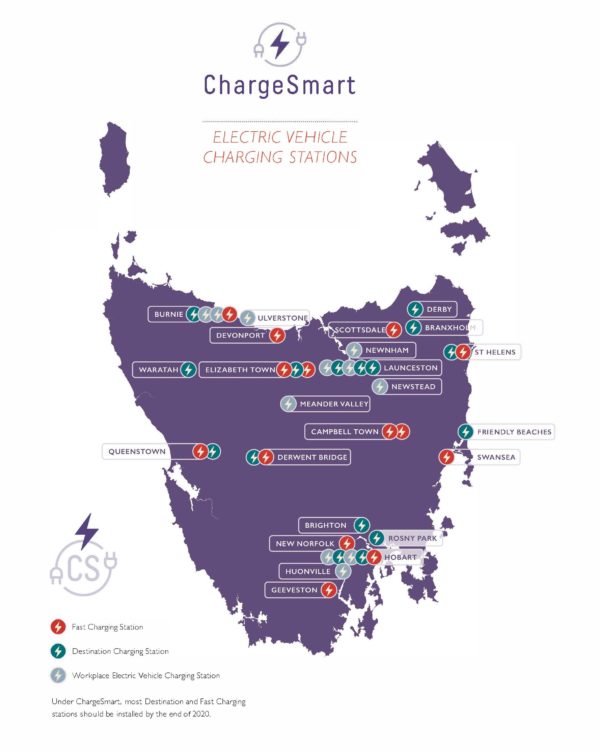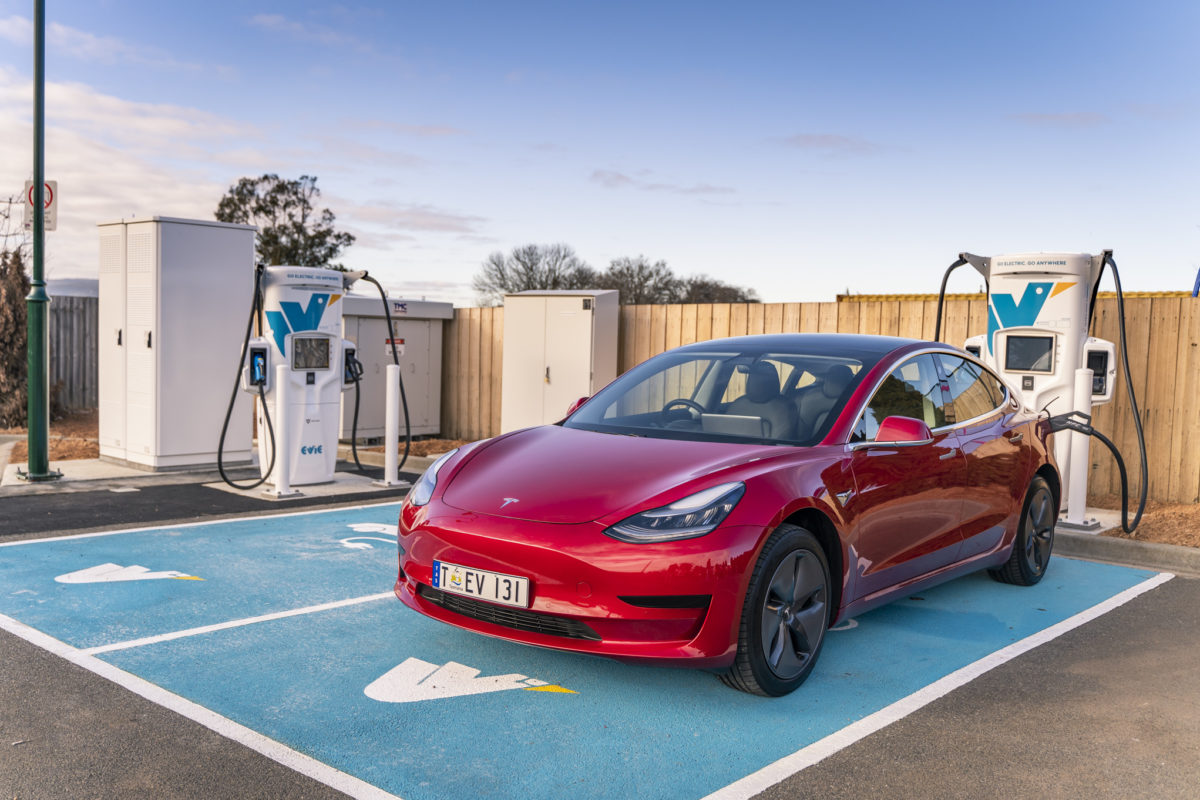Since the era of bullock-drawn drays, Campbell Town between Launceston and Hobart has been a recharging post for travellers on Tasmania’s eastern side. Last week saw the opening of EV Networks’ first Tasmanian ultra-fast EV charging site in the car park of Northern Midlands Council in Commonwealth Lane.
Campbell Town is the sixth in Evie Networks’ roll out of some 42 planned national ultra-fast-charging sites, and the commissioning of two Australian-developed and manufactured Tritium Veefil-PK 350kW DC chargers was enthusiastically attended by members of the Australian Electric Vehicle Association, early adopters for whom every new charging opportunity is cause for celebration.
Evie Networks will provide three ultra-fast charging opportunities for EV drivers in Tasmania, two of which – Campbell Town and Westbury (30 kilometres west of Launceston) – are supported by the Tasmanian Government’s Electric Vehicle ChargeSmart Grants Programs.
These programs, initiated in 2017, were designed to fund three categories of chargers: fast-charging sites located with organisations such as councils; destination charging stations at sites such as hotels and tourist attractions; and chargers at workplaces such as universities.
“It’s a great program by the Tasmanian Government,” says Chris Mills, CEO of Evie Networks, who adds that its funding of 12 new fast-charging sites, plus a couple of existing fast charging opportunities, and his company’s imminent third site just north of Hobart at Kempton will ensure that “there isn’t really a part of Tasmania that’s not within 150 km at the most from a fast charger”.

Image: Tasmanian Government
Development of some sites has been slowed by Covid-19, which impacted Evie Networks’ ability to find local suppliers for construction and connection of its infrastructure. Nonetheless, Mills is hopeful that the Kempton site will go live by the end of 2020, while energy supply to the Westbury site is brought on line.
Little known hazard on the road to EV transition: energising the chargers
Mills told pv magazine that the longest lead time in developing each site is usually for getting power supplied, and in negotiating tariffs which are set on a five-year cycle and don’t yet take into account the needs of EV charging.
“We’ve been working with each of the state governments who have all been responsive, on looking at ways in which we can promote the uptake of electric vehicles and work with electricity providers, educating them on the difference in load profiles between an electric vehicle charging station and, say, a factory,” says Mills.
Applying historically set tariffs that have no reference to the energy load profile of EV charging can render the cost of plugging in “exorbitant”, says Mills.
In Tasmania, he says, Evie Networks worked with progressive network provider TasNetworks to arrive at a tariff within the suite of available charges. In other states, he says, the company has negotiated toward a tariff that makes sense, in time for the next tariff submission statement in the five-year regulatory-control period.
In playing this long game, Evie Networks also ensures each of its highway sites is capable of supporting up to six charging bays, even though most sites will open with two chargers.
It has become an Evie Networks tradition to offer free charging to those who visit a new facility within the first month of operation. This naturally draws as many locals and passersby as are in the region, boosting familiarity with the site, before user pays cuts in and usage settles to the typical trickle of “single-digit percentage utilisation” as Mills describes it.
He explains, “One percent utilisation is a quarter of an hour a day, and we probably see less than an hour a day at the beginning” of the life of a new site, “which is expected”.
Competition or coverage?
Further considerations in the roll out of infrastructure include whether or not to compete with other providers on potentially lucrative routes.
Evie Networks has decided not to duplicate charging opportunities, but to work on weaving a nationwide fabric of charging opportunities that leaves no driver stranded or uncertain about the options for reaching their next destination.
“We don’t see other charging networks as our competitors,” says Mills. “We see the petrol car as our competitor and the aim is to help people make the change from a petrol car to an electric vehicle; to do that we have to have as broad a network as we possibly can.”
As a result, the planned ultra-fast-charging Evie highway network begins in Gordonvale, just south of Cairns, tops up in Townsville, and again in Proserpine before handing over to Queensland’s Electric Super Highway. In New South Wales it will seek to enable EV drivers to charge up in Penrith, which will carry them to another site in the Blue Mountains, and then across to Lithgow before handing over to the NRMA regional network of EV fast chargers.
Prioritising security, amenity and delight
Specific site selection for Evie Networks prioritises driver safety, ensuring each destination is well lit and supported by security measures. “You don’t want anyone to feel nervous, frightened or exposed,” asserts Mills.
Easy access from both sides of the carriageway is the second most important factor in selecting real estate, but Evie Networks is also alert to the need for amenities and activities.
“One of the great things about electric vehicles is you don’t have to be with the car while it’s charging,” says Mills. You can lock it and make use of refreshments or the sights in the vicinity.
In Campbell Town, although drivers can recharge within 15 minutes, Mills says, “The tranquil Elizabeth River and heritage-listed city centre will likely see drivers enjoying a leisurely break before hitting the road again.
“Evie Networks is excited to enable EV drivers to travel beyond the city and enjoy more of Tasmania’s incredible scenery and history,” he adds.
Unlocking the electric road from Launceston to Hobart is part of the company’s vision of catering to all owners of electrically powered vehicles and, in this case, their aspirations to enjoy everything the historic and scenic route has to offer or just get efficiently from north to south and back again.
This content is protected by copyright and may not be reused. If you want to cooperate with us and would like to reuse some of our content, please contact: editors@pv-magazine.com.









By submitting this form you agree to pv magazine using your data for the purposes of publishing your comment.
Your personal data will only be disclosed or otherwise transmitted to third parties for the purposes of spam filtering or if this is necessary for technical maintenance of the website. Any other transfer to third parties will not take place unless this is justified on the basis of applicable data protection regulations or if pv magazine is legally obliged to do so.
You may revoke this consent at any time with effect for the future, in which case your personal data will be deleted immediately. Otherwise, your data will be deleted if pv magazine has processed your request or the purpose of data storage is fulfilled.
Further information on data privacy can be found in our Data Protection Policy.